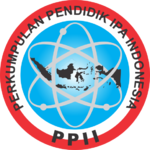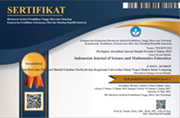STEM Multimedia to Stimulate HOTS in Renewable Energy Material
Abstract
Keywords
Full Text:
PDFReferences
G. Ghufron, “Revolusi Industri 4.0: Tantangan, Peluang, dan solusi bagi dunia pendidikan,” in Seminar Nasional Dan Diskusi Panel Multidisiplin Hasil Penelitian Dan Pengabdian Kepada Masyarakat 2018, vol. 1, no. 1, 2018, pp. 332-337.
R. F. Nikat, M. Loupatty, and S. H. Zahroh, “Kajian Pendekatan Multirepresentasi dalam Konteks Pembelajaran Fisika,” J. Pendidik. dan Ilmu Fis., vol. 1, no. 2, pp. 45-53, 2021.
R. Rudianto, R. Diani, S. Subandi, and N. Widiawati, “Development of assessment instruments 4C skills (critical thinking, collaboration, communication, and creativity) on parabolic motion materials,” J. Adv. Sci. Math. Educ., vol. 2, no. 2, pp. 65–79, 2022.
L. W. Anderson and D. R. Krathwohl, A taxonomy for learning, teaching, and assessing: A revision of Bloom’s taxonomy of educational objectives: complete edition. Paris: Addison Wesley Longman, 2001.
H. Akhsan, K. Wiyono, M. Ariska, and N. E. Melvany, “Development of HOTS (higher order thinking skills) test instruments for the concept of fluid and harmonic vibrations for high schools,” in Journal of Physics: Conference Series, vol. 1480, no. 1, 2020, pp. 1-5.
I. W. Widana, “Higher Order Thinking Skills Assessment (Hots),” Jisae J. Indones. Student Assesment Eval., vol. 3, no. 1, pp. 32–44, 2017.
H. Usman, “Manajemen: teori, praktik dan riset pendidikan. edisi ketiga,” Jakarta bumi aksara, 2010.
S. K. Reed, “Cognitive architectures for multimedia learning,” Educ. Psychol., vol. 41, no. 2, pp. 87–98, 2006.
B. Waldrip, V. Prain, and J. Carolan, “Using multi-modal representations to improve learning in junior secondary science,” Res. Sci. Educ., vol. 40, no. 1, pp. 65–80, 2010.
G. Gunawan, A. Harjono, and S. Sutrio, “Multimedia Interaktif dalam Pembelajaran Konsep Listrik bagi Calon Guru,” J. Pendidik. Fis. dan Teknol., vol. 1, no. 1, pp. 9-14, 2017.
H. R. Sadaghiani, “Controlled study on the effectiveness of multimedia learning modules for teaching mechanics,” Phys. Rev. Spec. Top. - Phys. Educ. Res., vol. 8, no. 1, pp. 1–7, 2012.
J. Twidell, Renewable energy resources. London: Routledge, 2021.
M. Maulidia, P. Dargusch, P. Ashworth, and F. Ardiansyah, “Rethinking renewable energy targets and electricity sector reform in Indonesia: A private sector perspective,” Renew. Sustain. Energy Rev., vol. 101, no. 1, pp. 231–247, 2019.
T. R. Kelley and J. G. Knowles, “A conceptual framework for integrated STEM education,” Int. J. STEM Educ., vol. 3, no. 1, pp. 1–11, 2016.
I. Fiteriani, R. Diani, A. Hamidah, and C. Anwar, “Project-based learning through STEM approach: Is it effective to improve students’ creative problem-solving ability and metacognitive skills in physics learning?,” IOP Conf. Ser. Earth Environ. Sci., vol. 1796, no. 1, 2021, pp. 1-13.
S. Hanif, A. F. C. Wijaya, and N. Winarno, “Enhancing Students’ Creativity through STEM Project-Based Learning.,” J. Sci. Learn., vol. 2, no. 2, pp. 50–57, 2019.
J. Afriana, A. Permanasari, and A. Fitriani, “Penerapan Project Based Learning Terintegrasi STEM untuk Meningkatkan Literasi Sains Siswa Ditinjau dari Gender Implementation Project-Based Learning Integrated STEM to Improve Scientific Literacy Based on Gender,” vol. 2, no. 2, pp. 202–212, 2016.
L. Pramuji, A. Permanasari, and D. Ardianto, “Multimedia Interaktif Berbasis STEM Pada Konsep Pencemaran Lingkungan Untuk Meningkatkan Kemampuan Berpikir Kritis Siswa,” J. Sci. Educ. Pract., vol. 2, pp. 1–15, 2018.
J. A. Putri, P. Parno, M. F. Marsuki, E. Hamimi, and I. J. Fitriyah, “Development of STEM-based animation interactive multimedia with feedback to improve students’ creative thinking ability on motion topic,” in AIP Conference Proceedings, vol. 2619, no. 1, 2023, pp. 1-9.
L. A. Khairani, E. Djulia, and W. Bunawan, “Interactive multimedia development based on stem in improving science learning outcomes,” Randwick Int. Educ. Linguist. Sci. J., vol. 4, no. 2, pp. 428–435, 2023.
I. Diansah, A. Suyatna, and Viyanti, “STEM-based physics multimedia design for stimulating HOTS on water and wind energy topic: Physics teacher perception,” IOP Conf. Ser. Earth Environ. Sci., vol. 1796, no. 1, 2021, pp. 1-10.
E. Widyastuti, “Using the ADDIE model to develop learning material for actuarial mathematics,” in Journal of Physics: Conference Series, vol. 1188, no. 1, 2019, pp. 1-8.
Y. A. Angwal, “Effects of Integrated Stem Approach Towards Secondary School Students Critical Thinking Skills and Achievement in Genetics.” University of Malaya (Malaysia), 2019.
D. Misesani, W. O. Janggo, and M. S. N. Wuwur, “Need analysis in ADDIE model to develop academic speaking materials,” Ethical Ling. J. Lang. Teach. Lit., vol. 7, no. 2, pp. 438–446, 2020.
Z. Amir and N. Sari, “The development of learning media based on visual, auditory, and kinesthetic (VAK) approach to facilitate students’ mathematical understanding ability,” in Journal of Physics: Conference Series, vol. 1028, no. 1, 2018, pp. 1-8.
S. Sofiyan, R. Amalia, and A. B. Suwardi, “Development of mathematical teaching materials based on project-based learning to improve students’ HOTS and character,” in Journal of Physics: Conference Series, 2020, vol. 1460, no. 1, pp. 1-10.
M. Delucchi, “Measuring student learning in social statistics: A pretest-posttest study of knowledge gain,” Teach. Sociol., vol. 42, no. 3, pp. 231–239, 2014.
F. A. Arifin and F. Mufit, “Validity and practicality of interactive multimedia based on cognitive conflict integrated new literacy on thermodynamic and mechanical waves material for class xi high school students,” in Journal of Physics: Conference Series, vol. 1876, no. 1, 2021, pp. 1-10.
N. S. Herawati and A. Muhtadi, “Pengembangan modul elektronik (e-modul) interaktif pada mata pelajaran Kimia kelas XI SMA,” J. Inov. Teknol. Pendidik., vol. 5, no. 2, pp. 180–191, 2018.
M. Heo, N. Kim, and M. S. Faith, “Statistical power as a function of Cronbach alpha of instrument questionnaire items,” BMC Med. Res. Methodol., vol. 15, no. 1, pp. 1–9, 2015.
R. E. Mayer, The Cambridge handbook of multimedia learning. Cambridge: Cambridge university press, 2005.
M. Isdianti, H. Nasrudin, and E. Erman, “The effectiveness of STEM based inquiry learning packages to improving students’ critical thinking skill,” J. Educ. Gift. Young Sci., vol. 9, no. 3, pp. 223–232, 2021.
DOI: http://dx.doi.org/10.24042/ijsme.v6i3.25150
Refbacks
- There are currently no refbacks.
Copyright (c) 2023 Unit Riset dan Publikasi Ilmiah Fakultas Tarbiyah dan Keguruan Universitas Islam Negeri Raden Intan Lampung

This work is licensed under a Creative Commons Attribution-ShareAlike 4.0 International License.

Indonesian Journal of Science and Mathematics Education is licensed under a Creative Commons Attribution-ShareAlike 4.0 International License.




